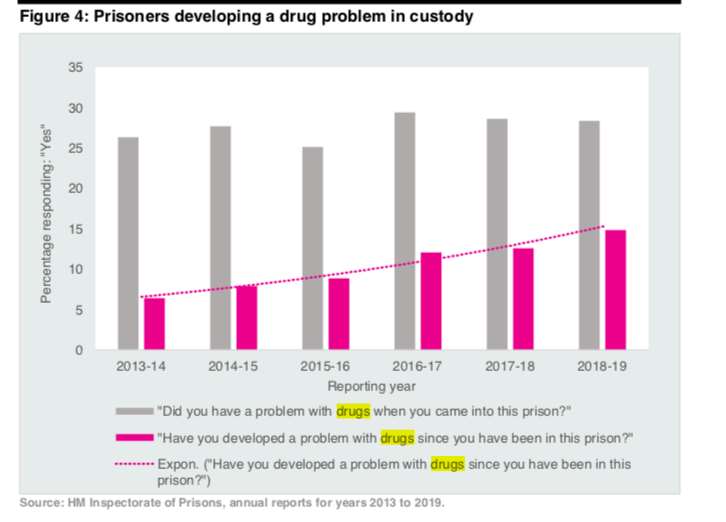The number of prisoners who say they have developed a drug problem in custody has more than doubled in the last five years. According to a new report by the thinktank Reform almost half (48%) of men surveyed by the HM Inspectorate of Prison who reported having a drug problem said that it was easy to get drugs.
Reform make a series of recommendations including looking at a ban on short custodial sentences as well as ways to make magistrates more willing to use community sentences which the group argues are less expensive and more effective at reducing reoffending. The group also call on ministers to fund the Ministry of Justice £900 million to tackle the maintenance backlog and additional annual funding to disrupt the supply of contraband in the long term.
Nearly half of all prison sentences are ‘short’ custodial sentences of six months or less. ‘These carry a very high reoffending rate of 65% – for theft offences specifically, it is 82% – and this has remained around this level for over ten years,’ the group says; adding that the reoffending rate for suspended sentence orders and community sentences was only 33%.
Reform also points out that, at just under £4,500 annually, a community sentence costs just over ‘a tenth of the cost of imprisonment’. ‘It has been estimated that the Government would accrue savings of at least £83 million a year if community sentences were used instead of short prison sentences for theft and non-violent drug offences,’ the group argues. Meanwhile the use of custodial sentences have dramatically dropped – see below.

The report points to a dramatic decline in the safety of staff and prisoners in the last decade. Between June 2010 and June 2019 prisoner-on-prisoner assaults rose by 107%; prisoner-on-staff assaults by 250%; and self-harm rose 135%. ‘The presence of drugs, especially psychoactive substances, has a significant impact on levels of violence across the estate,’ the group said.
‘Stabilising the system means stemming the flow of drugs, reducing overcrowding, fixing the crumbling estate and improving officer retention. Its long-term sustainability requires a serious conversation about how many people we lock up and for how long. Failing to act will mean poorer social outcomes, more reoffending and ultimately huge costs to the taxpayer.’
Aidan Shilson-Thomas, Reform researcher
Since the Government’s 2016 White Paper, ‘Prison Safety and Reform with its plans for ‘the biggest overhaul of our prisons in a generation’:
- Prisoner-on-prisoner and prisoner-on-staff assaults have increased by 30%
- Incidents of prisoners self-harming have increased by 65%
- The leaving rate for prison officers has increased by 32%
- In the 12 months to March 2019, 17% of drug tests on prisoners were positive
- Nearly £529 million intended for spending on the prison estate has been diverted to spending on the day-to-day running of prisons







